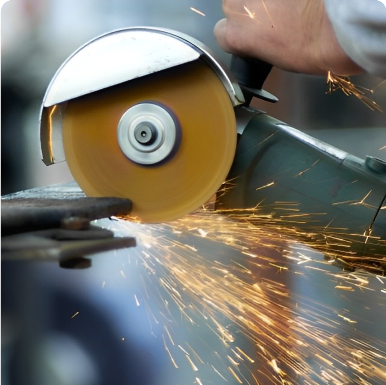Different Types of Abrasive Wheels
Abrasive wheels are a crucial component in various industries, from metalworking to construction. These wheels are designed to grind, cut, or polish materials using the principles of abrasion. Understanding the different types of abrasive wheels is essential for selecting the right tool for a specific application. This article explores the various types of abrasive wheels, their uses, and their characteristics.
1. Grinding Wheels
Grinding wheels are perhaps the most commonly recognized type of abrasive wheel. They consist of a composite material that includes abrasive grains, bonding agents, and fillers. Grinding wheels come in various shapes and sizes, tailored for different grinding processes. These wheels are typically classified by their material composition, such as aluminum oxide, silicon carbide, and diamond.
- Aluminum Oxide Wheels These are widely used for general grinding purposes, including sharpening tools, polishing metals, and grinding non-ferrous materials. Their durability and effectiveness make them a popular choice in many industrial settings.
- Silicon Carbide Wheels Known for their sharpness and hardness, these wheels are ideal for grinding hard materials like ceramics, glass, and some metals. They are often employed in applications requiring precise finishing and surface preparation.
- Diamond Wheels These are the hardest type of grinding wheels, primarily used for machining hard materials such as concrete, stone, and ceramics. Diamond wheels provide exceptional longevity and cutting efficiency, though they tend to be more expensive than other types.
2. Cutting Wheels
Cutting wheels are designed specifically for slicing through metal and other tough materials. They are typically thinner than grinding wheels and must be used with precision tools like angle grinders. Cutting wheels are available in a range of sizes and compositions, ensuring versatility across various cutting tasks.
- Metal Cutting Wheels These wheels are often made from aluminum oxide or a combination of abrasive materials, providing effective cutting action for ferrous and non-ferrous metals
. They are commonly used in fabrication shops and construction sites.- Concrete Cutting Wheels Specifically engineered for cutting through concrete, asphalt, and masonry, these wheels are usually reinforced with steel for added durability. They can handle the rigors of heavy-duty applications, making them indispensable in the construction industry.
different types of abrasive wheels

3. Flap Discs
Flap discs are a unique type of abrasive wheel that consists of multiple layers of abrasive material arranged in a “flap” configuration. These discs are primarily used for grinding, finishing, and polishing tasks. Their versatility allows them to achieve various surface finishes while also providing efficient material removal.
- Aluminum Oxide Flap Discs Commonly used for metalworking applications, these discs are effective for grinding and blending welds, removing rust, and polishing surfaces.
- Zirconia Flap Discs These discs are designed for aggressive grinding applications on tougher materials. Their durability makes them suitable for heavy-duty tasks in metal fabrication.
4. Buffing and Polishing Wheels
Buffing and polishing wheels are designed for achieving a high-gloss finish on various materials, including metals, plastics, and wood. These wheels are typically softer and use finer abrasive materials.
- Cotton Buffing Wheels These wheels are made from layers of cotton and are ideal for polishing tasks. They are often used with polishing compounds to create a smooth, reflective surface on metals.
- Felt Polishing Wheels Similar to cotton wheels, felt wheels are used for fine polishing applications. They are particularly useful in jewelry making and other applications requiring a high degree of precision.
Conclusion
In conclusion, the selection of abrasive wheels is vital for achieving optimal results in grinding, cutting, and polishing tasks across various industries. Each type of abrasive wheel serves a distinct purpose, with specific characteristics suited for different materials and applications. Whether dealing with hard metals, concrete, or delicate finishes, understanding the various types of abrasive wheels ensures that professionals can choose the right tools for their specific needs, contributing to efficiency, precision, and overall project success.
Post time:Dec - 21 - 2024

















